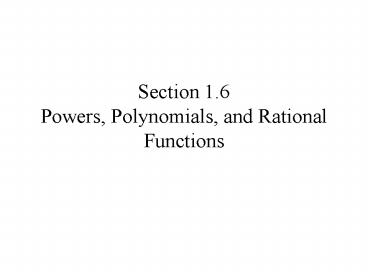Section 1'6 Powers, Polynomials, and Rational Functions - PowerPoint PPT Presentation
1 / 12
Title:
Section 1'6 Powers, Polynomials, and Rational Functions
Description:
The long-run behavior is determined by the leading terms of both p and q. These functions often have horizontal asymptotes which define their long run behavior ... – PowerPoint PPT presentation
Number of Views:53
Avg rating:3.0/5.0
Title: Section 1'6 Powers, Polynomials, and Rational Functions
1
Section 1.6Powers, Polynomials, and Rational
Functions
2
- A quantity y is directly proportional to a power
of x if - A quantity y is inversely proportional to a power
of x if - Functions of this form are called power functions
3
- Which of the following are power functions and
identify the k and the n (recall )
4
- Power functions can be odd, even or neither
- How can we decide?
- What about the following?
- What about the end behavior of a power function
versus an exponential - Which grows faster?
5
- What happens if we add or subtract power
functions? - A polynomial is a sum (or difference) of power
functions whose exponents are nonnegative
integers - What determines the degree of a polynomial?
- For example
- What is the leading term in this polynomial?
6
- We have the general form of a polynomial which
can be written as - Where n is a positive integer called the degree
of p - Each power function is called a term
- The constants an , an-1, a0,are called
coefficients - The term a0 is called the constant term
- The term anxn is called the leading term
7
End Behavior The shape of the graph of a
polynomial function depends on the degree. Degree
EVEN Degree ODD
angt0
anlt0
angt0
anlt0
8
- What are the zeros (or roots) of a polynomial?
- Where the graph hits the x-axis
- The input(s) that make the polynomial equal to 0
- How can we find zeros of a polynomial?
- For example, what are the zeros of
- Notice this polynomial is in its factored form
- It is written as a product of its linear factors
- A polynomial of degree n can have at most n real
zeros
9
- When a polynomial, p, has a repeated linear
factor, then it has a multiple root - If the factor (x - k) is repeated an even number
of times, the graph does not cross the x-axis at
x k. It bounces off. The higher the (even)
exponent, the flatter the graph appears around x
k. - If the factor (x - k) is repeated an odd number
of times, the graph does cross the x-axis at x
k. It appears to flatten out. The higher the
(odd) exponent, the flatter it appears around x
k.
10
- If r can be written as the ratio of polynomial
functions p(x) and q(x), - then r is called a rational function
- The long-run behavior is determined by the
leading terms of both p and q - These functions often have horizontal asymptotes
which define their long run behavior
11
- We have three cases
- The degree of p lt the degree of q
- The horizontal asymptote is the line y 0
- The degree of p gt the degree of q
- There is no horizontal asymptote
- The degree of p the degree of q
- The horizontal asymptote is the ratio of the
coefficients of the leading terms of p and q
12
- Lets consider the following functions
- How do we find their x-intercepts?
- What are they?
- What happens if the denominators equal 0?
- What are their horizontal asymptotes?































